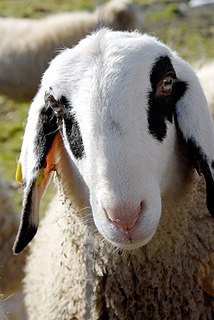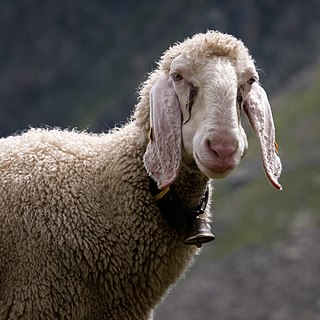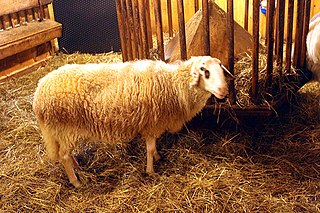
The Orobica or Valgerola is a breed of domestic goat from the Val Gerola in the province of Sondrio, in the Bergamo Alps of northern Italy. It is raised in the Val Gerola and the Valchiavenna in the province of Sondrio, in the Alto Lario Occidentale, the Valsassina and the Val Varrone in the province of Como, and in the upper Val Brembana in the Province of Bergamo. The origins of the breed are unknown; it is first documented at the beginning of the twentieth century. The Orobica is one of the eight autochthonous Italian goat breeds for which a genealogical herdbook is kept by the Associazione Nazionale della Pastorizia, the Italian national association of sheep-breeders.
The Bovec is a breed of domestic sheep from the upper valley of the Soča or Isonzo river, now in Slovenia. The breed is named in both Slovenian and in Italian for the town of Bovec or Plezzo; in the Trenta valley it may also be called Trentarka. It is raised in the Soča valley in Slovenia, in the areas of Resia and Tarvisio in Friuli in Italy, and in Styria and Carinthia in Austria. The breed is raised for milk and for meat.

The Jezersko–Solčava is a breed of domestic sheep from the eastern Alpine region of Europe. Until the outbreak of the First World War it was the most numerous sheep breed in southern Carinthia, in Friuli and in Slovenia. Its name derives from the regions of Jezersko and of Solčava, formerly in the Austrian Empire, now in Slovenia. It is raised also in parts of Austria, Germany and Italy; a small number were imported to Serbia in 1991. It may also be known as the German: Kärntner Brillenschaf, Seeländer Schaf or Villnösser Schaf, or as the Slovene: Jezersko-Solčavska Ovca.

The Brigasca, French: Brigasque, is a breed of sheep from Liguria in north-west Italy and the département of Alpes-Maritimes in south-eastern France. It takes its name from the town of La Brigue, which was until 1947 in the Italian province of Cuneo. The Brigasca is raised in the provinces of Imperia and Savona in Italy, and neighbouring areas in France. It appears to have origins in common with the Frabosana and Delle Langhe breeds. It is one of the forty-two autochthonous local sheep breeds of limited distribution for which a herdbook is kept by the Associazione Nazionale della Pastorizia, the Italian national association of sheep-breeders.
The Finarda is a breed of large domestic sheep from the regions of Lombardy and Piemonte in northern Italy. It is heavy breed raised mainly for meat, although it also yields 4–6 kg of wool per year. It results from cross-breeding the Bergamasca and Biellese breeds. It is one of the forty-two autochthonous local sheep breeds of limited distribution for which a herdbook is kept by the Associazione Nazionale della Pastorizia, the Italian national association of sheep-breeders. However, in 2008 the herdbook was empty, and may in fact never have been activated. Most data for the breed dates from 1983.
The Frabosana is a breed of sheep from the valleys of the Monregalese, the area around Mondovì in the province of Cuneo, in Piemonte in north-west Italy. It takes its name from the comuni of Frabosa Soprana and Frabosa Sottana, and was once the most numerous sheep breed of Piemonte. It is raised in the Valle Gesso, the Valle Grana, the Valle Pesio, the Valle Vermenagna and the Valli Monregalesi in the province of Cuneo, and in the Val Pellice in the province of Turin. Two types are recognised within the breed, the Roaschino in the Ligurian Alps, and the slightly smaller Frabosana raised in the area of Mondovì. The Frabosana is one of the forty-two autochthonous local sheep breeds of limited distribution for which a herdbook is kept by the Associazione Nazionale della Pastorizia, the Italian national association of sheep-breeders.
The Istriana or Carsolina, Croatian: 'Istarska Ovca', Slovene: 'Istrska Pramenka', is a breed of domestic sheep from Istria and the Karst regions of the northern Adriatic, from north-east Italy to Croatia and Slovenia.
The Pomarancina is a breed of domestic sheep from Tuscany in central Italy. It is raised mainly in the comune of Pomarance, from which it takes its name, and in the neighbouring comuni of Castelnuovo di Val di Cecina, Montecatini Val di Cecina and Volterra, all in the province of Pisa; some are kept in other parts of Tuscany, in the provinces of Grosseto, Livorno, Lucca and Siena. It is one of the forty-two autochthonous local sheep breeds of limited distribution for which a herdbook is kept by the Associazione Nazionale della Pastorizia, the Italian national association of sheep-breeders.
The Pusterese is a breed of domestic sheep from the autonomous province of Bolzano in northern Italy. It may also be called the Pustera gigante, Nobile di Badia or Gadertaler. It is raised mainly in the Val Pusteria (Pustertal), from which it takes its name, and in the Val Gardena; it has been reported also from the province of Belluno. The origins of the breed are unclear; it probably originates from the Tirol, but has also been influenced by the Lamon. It is one of the forty-two autochthonous local sheep breeds of limited distribution for which a herdbook is kept by the Associazione Nazionale della Pastorizia, the Italian national association of sheep-breeders.
The Saltasassi is an Italian breed of upland sheep, reared for meat. It originates in the provinces of Verbano Cusio Ossola and Novara in the northern part of Piemonte, in north-west Italy. It is one of the forty-two autochthonous local sheep breeds of limited distribution for which a herdbook is kept by the Associazione Nazionale della Pastorizia, the Italian national association of sheep-breeders.
The Sambucana or Demontina is a breed of upland sheep from the province of Cuneo, in Piemonte, north-west Italy. It takes its name from the comune of Sambuco in the Valle Stura di Demonte, the area where it is thought to have originated; the other name of the breed, Demontina, derives from the name of that valley. The Sambucana is also raised in the adjoining valleys, the Valle Gesso, the Valle Grana and the Valle Maira. It is one of the forty-two autochthonous local sheep breeds of limited distribution for which a herdbook is kept by the Associazione Nazionale della Pastorizia, the Italian national association of sheep-breeders.
The Varesina is a rare breed of domestic sheep from the province of Varese in Lombardy, in northern Italy. It originates from the area of Biandronno and Travedona; members of the breed have been identified in the comuni of Albizzate and Arcisate. The Varesina is closely related to the Bergamasca and the Biellese, but is smaller. It is one of the forty-two autochthonous local sheep breeds of limited distribution for which a herdbook is kept by the Associazione Nazionale della Pastorizia, the Italian national association of sheep-breeders.

The Tiroler Bergschaf or Pecora Alpina Tirolese is a breed of domestic sheep from the mountainous Tyrol area of Austria and Italy. The name means "Tyrolean mountain sheep". It is raised throughout Austria and in the autonomous province of Bolzano in Italy. It results from cross-breeding between the Tiroler Steinschaf of the Tyrol with the Italian Bergamasca breed from the area of Bergamo. This is variously reported as having taken place in the first half of the 19th century and after the Second World War.

The Tiroler Steinschaf or Pecora della Roccia Tirolese is a breed of domestic sheep from the mountainous Tyrol area of Austria; a few are raised in Italy. The name means "Tyrolean rock sheep". It is raised in the states of Tyrol and Salzburg in Austria and in the autonomous province of Bolzano in Italy. It dates from the early 19th century and is the oldest Tyrolean sheep breed.
The Tacola is a breed of domestic sheep from the mountains of Piemonte in north-west Italy. It is raised in the provinces of Biella, Cuneo and Turin, particularly in the area of Biella and the Valsesia. It apparently derives from the Biellese, from which it is distinguished by its short ears. It is one of the forty-two autochthonous local sheep breeds of limited distribution for which a herdbook is kept by the Associazione Nazionale della Pastorizia, the Italian national association of sheep-breeders.
The Schwarzbraunes Bergschaf is a breed of domestic sheep from the area of the Jura mountains in Switzerland. It derives from the Swiss Frutigen, Jura, Roux-des-Bagnes, Saanen and Simmental breeds. The name means "black-brown mountain sheep". It is one of the four principal sheep breeds of Switzerland. It is present also in Austria, Germany and Italy, and in those countries is known as the Juraschaf.
The Sciara or Moscia Calabrese is an indigenous breed of domestic sheep from the provinces of Catanzaro and Cosenza, in Calabria in southern Italy. It is a hardy and frugal breed, well adapted to the poor and stony upland terrain of the area. Sources from the early 20th century describe it as dark-coloured; according to the breed standard, it should be white.
The Altamurana is a breed of sheep from the province of Bari, in Puglia in southern Italy. It takes its name from the town of Altamura, in the Murge. It is of Asiatic, possibly Syrian, origin. It is raised mainly in the provinces of Bari and Foggia. It was formerly considered a triple-purpose breed, yielding meat, milk, and wool; it is now kept principally for milk production. It yields approximately 65 kg of milk per lactation, with on average 7.5% fat and 6.5% protein.
The Laticauda is a breed of domestic sheep from Campania and Calabria, in southern Italy. It is a fat-tailed breed, which gives rise to the name Laticauda, "broad-tailed". It is raised mainly in its area of origin in the provinces of Avellino, Benevento and Caserta, but is also found in the provinces of Cosenza, Matera and Naples. Like the Barbaresca breed of Sicily, it appears to result from the hybridisation of local breeds with Barbary sheep of Maghrebi origin. It has been suggested that these were first brought to the area by the Bourbon king Charles VII of Naples.

The Chamois Coloured Goat, French: Chèvre chamoisée, German: Gämsfarbige Gebirgsziege, Italian: Camosciata delle Alpi, is an indigenous breed of domestic goat from Switzerland. It is distributed throughout Switzerland and in parts of northern Italy and Austria, and has been exported to other countries including France. There are two strains, a horned type from the Grisons or Graubünden in the eastern part of the country, and a hornless type from the former bezirk of Oberhasli and the area of Brienz and Lake Brienz in the Bernese Oberland in central Switzerland. In some countries the hornless variety may be considered a separate breed, the Oberhasli goat. The Swiss herd-book was established in 1930.










